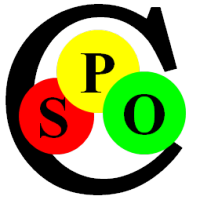The second Level of the semantic Web consists of Collection Counterparts to the Structures on the first Level of Individuals:
- Collections of similar Objects form Classes
- Collections of similar Properties form Predicates
- Collections of similar Relationships / Connections form Relations
Since in Spoc-Web all Things have unique Names and IDs, these Collections are actually mathematical Sets with distinct and not repeated Objects. The Importance of Similarity becomes very clear here. The Capability to recognize Similarities, but also to detect and describe Differences are Key Skills for this Level.
Classes = Sets of similar Things
Synonyms: Type, Table, Set, Collection, Schema
Classes are Collections of Things having the same Properties and Relationships. A Class does not only define its Members but also its Predicates and Relations. Classes are also Things, but abstract ones. They don't exist "in themselves", but as (mental) Models. But their Elements are mostly concrete Things. Classes also have a unique Name and can be stored in Spoc-Web. You can also model its Predicates and Relations in Spoc-Web, because it is semantically closed.
Predicates = Sets of comparable Properties
Synonyms: Property-Type, Quantity-Type, Attribute-Type
Predicates are Collections of Properties with the same Meaning and unified Measue.
Unification is important to be able to compare Property Values with each other. Systems of "Units" have been created by Standards Bodies to measure e.g. physical Properties. Among these Predicates are for Example the "Second" as the Unit of Time or the "Meter" as a Unit of Length (in all 3 Dimensionens: Length, Height and Width) and many more.
Spoc-Web comes with the physical SI Units (Systéme Internationale) and ca. 500 more Predicate already defined to enable a unified Description of Properties. When You import Data with different Units (say "miles") it is important to use different Predicates, even if the Properties describe the same (physical) Dimension. But You should try to convert to Standard Units. That makes the Properties universally comparable and thus much more useful!
Relations = Sets of comparable Connections
Synonyms: Relationship-Type, Relation
Relations are Collections of Relationships with similar Meaning. Like Predicates there may be different Relations describing the same or similar Relation, so try to choose one of the 130 Predicates already defined in Spoc-Web.
We must distinguish between
- binary Relations between two Sets and
- higher-dimensional (N-ary) Relations between N Sets
Binary Relationen consist of Connections between two Objects. These are directly displayed as Arrows or Lines in Spoc-Web. Most Relations are binary and higher N-ary Relations can be broken down into N binary Relations.
Example: the Class of "Computers"
Engineered Things provide good Examples, because they are so thoroughly understood and described that You can build them. Let's take the Class of "Personal Computers". This is a bit more restricted than just "Computers", because otherwise we would have to describe very different Things like Mobile Phones, Pocket Calculators etc.
PCs have many Parts with very specific Functions. These form a higher-dimensional Relation "Computer Parts", because without them a Computer would not be a Computer or simply "broken":
- CPU, the Processor
- RAM, the "Memory" of the Machine
- Hard Drive, the permanent "Memory"
- GPU, the Graphics Processor
- Power Supply
- ...
In Spoc-Web You would model the concrete Computer, say your Desktop Computer as a distinct Thing with a uniqe Name, say "My Desktop Computer" and connect it to Things like "My Intel CPU", "My 4GB RAM", "My 2TB Hard Drive" that You also model as Things.
Breaking up high-dimensional Relations: Computer Example
The Connections You use to connect the Parts to the Computer should be from different Relations:
- Use "is the CPU of" to connect the Processor with the Computer
- Use "is the Memory of" to connect "My 4GB RAM" with the Computer
- and so on...
The high-Level Relation "Computer Parts" has been broken into simple binary Relations that describe the Function of the Parts in the Computer. You receive a well readably Model of the real World consisting of a Collection of semantic Triplets (Subject -> Predicate -> Object):
- "My Intel CPU" -> "is the CPU of" -> "My Desktop Computer"
- "My 4GB RAM" -> "is the Memory of" -> "My Desktop Computer"
- etc.
Best Practices in definiting Relations
When You create or break up new Relations, there are always two possible binäry Relations: the active Form and the passive Form. Both are inverse to each other; You can always replace one by the other by swapping Subject and Object and inverting the Predikate. Try to use Relations that direct from the Part to the Whole. This avoids Redundancies and others will benefit from the Consistency by quickly understanding Your Models.
In many Situations generalized Relationen are sufficient, like "is Part of", because it is clear from the Parts Class, which Role it (should) assume.




